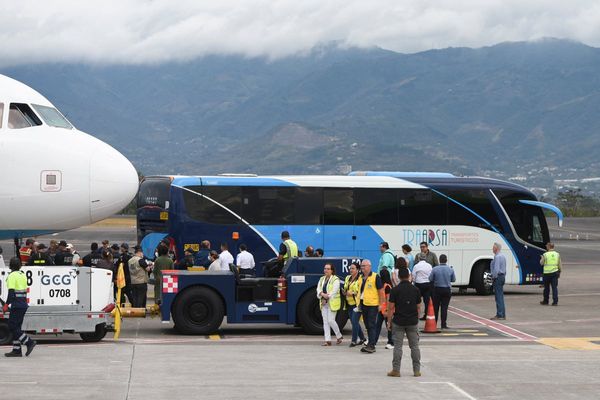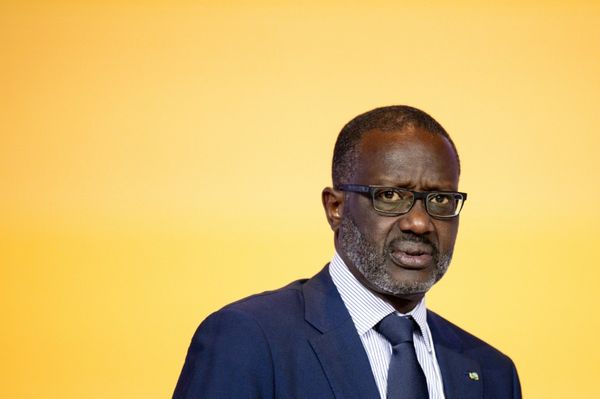
The first thing the three militants did on entering Syria’s notorious Palestine branch prison as free men was to search for their former solitary confinement cells. They crossed under the towering iron gates and barbed wire at the edge of the Damascus complex after the fall of Bashar al-Assad and headed immediately to the squalid cells just a few feet wide where they had spent years huddled in the dark, staring at the back of the heavy metal doors and drawing on the walls.
Mahmoud Chtawi said that when he entered he lifted his head to gaze up at the 10-storey concrete building just to prove to himself that he could. For decades, anyone passing the facility run by military intelligence was terrified to even steal a glance. He headed to find cell number 15, firing off rounds of bullets in celebration when he did. He then decided to spend the night inside his former cell to “process the memories” of his time there.
“When I stepped into the cell, I was thinking that finally this is justice,” he said.
A few feet away, Ibrahim Younis re-entered cell number nine and sat there for 10 minutes, musing on his promises to former prisoners during his time employed and later imprisoned in the Palestine branch that he would one day help free those unfairly detained.
Chtawi, Younis and his cousin Mahmoud Younis are among a band of fighters from the Islamist militant group Ahrar al-Sham – one of the groups that overran the detention sites that were a hallmark of Assad’s regime – standing guard outside the infamous facility in whose freezing cells they were once imprisoned and abused. The Palestine branch, also known as branch 235, was named for its role in the surveillance of Palestinian groups, but its name had been synonymous with torture for several decades.
All those outside said they hoped Syria’s new leadership would seek to transform the prison into a “place of justice” despite its past. Civilians including more former detainees filed in to its courtyard to report thefts and carjackings, or to sign up to work for Syria’s caretaker government. Many approached with some caution, warmly greeting the new guards, but unable to overlook their memories of what took place inside.
Ibrahim Younis was particularly pleased that people from the surrounding Damascus neighbourhood were arriving to report crimes. Projecting a business-like confidence despite the horrors he endured while detained, he has returned to his former job as an investigator two decades after he first started work there during Assad’s rule.
He had always liked solving crimes, he said, and first signed up to work as an investigator at the Palestine branch in 2005. This meant learning the details of interrogation techniques routinely used at the facility, witnessing officers hang detainees by a tyre to beat them, forcing them into stress positions or suspending them by their wrists.
Younis said he only ever observed the torture, but he fought back tears as he recalled looking into the eyes of one of his neighbours who was beaten to death. Then 24, he had started to recognise dozens of those being brought into the facility as the Assad regime cracked down on protests against his rule.
“They beat him to get the names of other demonstrators,” he said. “I watched him die right in front of my eyes from this torture. It taught me that the state wasn’t there to protect people, but just to keep its grip on power.”
The incident spurred Younis to pass information to demonstrators in his neighbourhood to help the anti-Assad movement. But his co-workers caught him, and by 2012 Younis and his cousin Mahmoud had been dragged into the Palestine branch and locked away in cells directly underneath his former office.
Mahmoud has not been able to forget what happened next. “I still have the scars on my body,” he said.
Long periods in solitary confinement were broken only when they were gathered in a room to await torture, sometimes made to crouch together naked as additional humiliation. Mahmoud recalled being intermittently given electric shocks or doused with filthy water, seeing dead bodies laying on the prison floor, and fearing that wounds from torture would fester enough to warrant a trip to a military hospital, where the doctors also harmed their patients.
Hundreds were held at a time in the filthy underground prison, including foreign nationals such as the Canadian Maher Arar, who was brought there under the CIA’s extraordinary rendition programme. Arar described being beaten with a two-inch thick electrical cable, and being forced to listen to others being abused until his jailers extracted a confession from him about visiting Afghanistan, a place where he had never set foot.
Among the charred rooms of the investigations department was one containing a dentist’s chair and equipment, which were likely to have been used for torture. On the prison floor an overturned cardboard box disgorged hundreds of packets of medication used to treat heart attacks, allowing staff to keep prisoners alive long enough to be abused again.
Mahmoud and Ibrahim were released after almost two years in the facility. Both immediately defected to opposition militias before fleeing to rebel-held pockets in the north of the country.
“Every night before the fall of the Assad regime I had nightmares that they would re-arrest me and bring me back here,” said Mahmoud. “This place itself is a nightmare.”
The cavernous interior of the deserted facility is now silent, save for investigators from Hay’at Tahrir al-Sham who came to rifle through a room full of papers. Other rooms that once contained wall-to-wall filing cabinets filled with details about the Assad regime’s suffocating surveillance have been reduced to nothing more than heaps of grey ash.
Members of Ahrar al-Sham accused another militia of torching key evidence at the facility in the hours after Assad’s officers had fled. The building’s upper floors that once housed the luxurious sleeping quarters of those in charge were coated in broken glass after being looted. Several of the cell doors still had heavy metal chains attached from when the prisoners inside were freed, the fetid smell of body odour lingering in the air.
Elsewhere reams of papers detailed how the branch surveilled its own citizens, down to precise details of rosary beads they carried when arrested, accusations that detainees had provided medical care to demonstrators or given details about their own family to a nephew. One document detailed a complaint about the branch’s ageing surveillance cameras, which lay on the ground after being ripped from the walls.
“People were slaughtered here, and there were acts of unimaginable psychological abuse. They threatened my family,” said Ahmad al-Homsi, who described how he lost 50kg (110lb) during his two years held in the Palestine branch.
“They could teach Satan about abuse here.” The torture had created rage within him that he said he was still struggling to manage, he said.
Standing under the towering iron gates of the facility for the first time as a free man, however, Homsi saw opportunity. He had just returned to Damascus from Turkey, he said, and had immediately headed to the former site of his suffering to volunteer.
“I want to do whatever I can to help the new government,” he said. As for what should happen to the hulking facility, he said he wanted those responsible for killing his two brothers in detention to be taken there.
Ibrahim Younis and the other militants were divided on what should happen to the Palestine branch. Chtawi thought it should be converted into a university building or hospital, arguing that a facility once known for abusing civilians should be symbolically transformed into a place of public service.
Younis was more cautious. He would never condone the branch being used for torture, he said, but felt that even the new Syria needed some form of intelligence services.
“We can keep this place for the general intelligence service, but like you see here, it should be a place that returns citizens’ rights,” he said, gesturing at the groups of people showing up to report thefts and other crimes. “It should be a place of justice, not one of injustice.”







